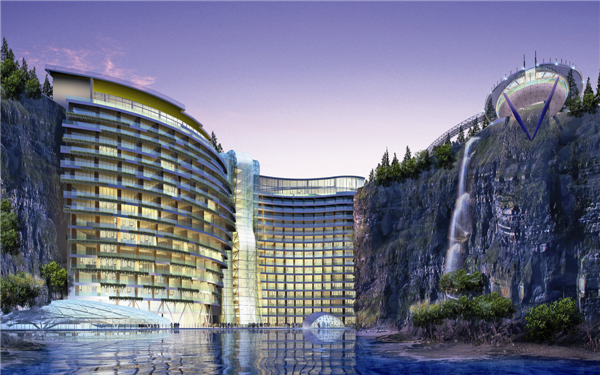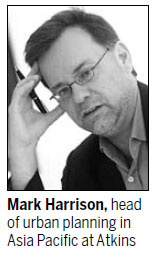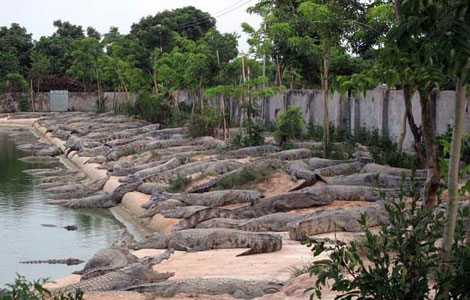Urban planners eye China's cities
Updated: 2013-06-22 08:58
By Cecily Liu (China Daily)
|
||||||||
 |
|
An artist's impression of the Shimao Wonderland InterContinental hotel designed by the UK's engineering consultancy Atkins. Provided to China Daily |
Urbanization has become the mother of invention in nation
China's rapidly growing built environment is inspiring urban planners to develop new ways of thinking, said Mark Harrison, head of urban planning in Asia Pacific at the United Kingdom's engineering consultancy Atkins.
"I think there are so many new ideas being developed and tested out in China, because China is urbanizing at such a rapid speed," Harrison said.

Harrison said one example is the incorporation of environmental sustainability considerations into a new city or town at the point of construction, as opposed to introducing measures to reduce environmental damage after it has occurred, which was the case in many European cities.
This is because Europe industrialized early and the environmental impact of the built environment was sometimes not properly considered, whereas China's newly built cities have the advantage of learning from Europe's mistakes, Harrison said.
"As climate change becomes more of a problem, it is increasingly important to consider factors like traffic, energy use, water use and waste in new cities at the beginning," he said.
Harrison's team, which comprises 150 urban planners, has completed more than 800 projects in China, in more than 100 cities.
One project is master planning for Songjiang New City, an area rich in history and culture near Shanghai, which was being turned into a new city under the Shanghai government's One City, Nine Towns plan, passed by the Shanghai Planning Commission in 2001.
"Songjiang has been developed using the garden city concept, which originated from England," Harrison said. "But different from England, Songjiang has higher density, which needed to be taken into account in the master planning process.
"Songjiang also has many aspects of traditional heritage and culture which we have integrated into our overall design."
The garden city concept, first proposed by the UK's urban planner Ebenezer Howard in 1898, emphasizes self-contained communities allowing residents to live harmoniously with their surroundings.
In the city plan Harrison's team created, modern leisure and recreational features such as a golf course co-exist with traditional landscape in a coherent manner "through careful consideration", he said.
The traditional landscape features have been incorporated into tourism locations, whereas more modern facilities are mostly used by the city's residents in their everyday lives.
"The key thing is to respect the heritage, and not to destroy it, and also to integrate them with the needs of modern life, transport and facilities," Harrison said.
Another feature in Songjiang in which Atkins helped with the architectural, structural and civil engineering work is the Shimao Wonderland InterContinental hotel, being built on the site of a 90-meter-deep abandoned quarry.
The five-star hotel is striking because it uses the existing landscape in an innovative way. As water already existed in the old quarry, Atkins has kept water as a main theme, turning the lowest level of the hotel into a venue for water sports, with a spa and a swimming pool. The underwater level is designed to host an aquarium.
"Because of the location, we couldn't build a tall tower, so we went down into the quarry and built an interesting design."
Apart from new construction projects, Harrison said his team is heavily involved in many regeneration projects to help cities cope with a growing urban population and give them a new look.
"Urban areas often just need a new look and refresh. Maybe they suffer from transport problems as car ownership increases rapidly. There may be other concerns such as water quality or the quality of the urban environment."
Harrison said one of his team's projects is providing guidelines on the regeneration work for Chengdu, capital of Sichuan province, a city known for its relaxed lifestyle but which has been transformed in recent years as a result of its fast-growing high-tech industries.
Features of the regeneration included increasing greenery and building more low-speed roads in the city center, adding central islands to pedestrian crossings to ensure safety, adding more leisure facilities such as shops and restaurants around big community parks, and increasing the use of green material for important public sector buildings.
"The key is to identify the real character of the area," Harrison said. "Chengdu has many lively areas, especially its markets. It also has many natural landscape features, like river courses. It is important to make sure they are retained and not destroyed.
"So regeneration is about identifying and building on the character of a city to make it livable."
Harrison said one clear advantage Atkins has in the field of regeneration is its engineering expertise in brownfield development. As the official engineering design services provider to the London Olympics last year, Atkins demonstrated its brownfield site regeneration expertise by turning an old industrial site into a vibrant, safe sports venue.
Most Viewed
Editor's Picks

|

|

|

|

|

|
Today's Top News
Filipino Chinese shot dead in S Philippines
Building collapse injures 4 in Texas university
FIFA not considering scrapping Confed Cup
Iraq attacks kill more than 30
Man arrested for killing six in Shanghai
Surveys show weak economic confidence
Plane crash kills 2 at US air show
Soccer fans despair as coach dumped
US Weekly

|

|















